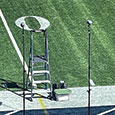To make your performances more consistent, start with good preparation, followed by flexibility when dealing with the many variables that we cannot control. Thorough preparation provides a sound foundation and allows you to adapt to the most challenging situations.
Preparation
Begin by knowing how the music should sound. This means listening to a recording, not just once, but many, many times. First listen to the recording following along with your solo part. Next listen following along with the piano score or full orchestral score. Another time listen to the recording without a score, taking in the details of the composition especially focusing on balance and timbre. Try playing along with the recording to see how the solo part fits in to the whole.
It is easier than ever to find access to recorded material. Online web sites have thousands of recordings that can be downloaded or arrive at your doorstep the next day. YouTube offers another avenue for listening. I am always shocked when students tell me they have not listened to their music as access to a large variety of recordings is easier today than it has ever been.
Practice
Practice teaches the body to be reliable under performance conditions. Productive practice skills reinforce good habits and retrain bad habits out of the fingers, tongue, ears, or brain. Thomas Nyfinger once said in a masterclass, “If you play everything correctly in practice, you have nothing to repair.” Make sure your first sightreading of new material is slow enough so your eyes are correctly reading the passages. Many times I have misread something while trying to save time by going too fast. This can create long-term errors that are hard to get rid of later. Use a metronome and tuner to check rhythm and intonation.
Dynamics and Expression
Dynamics will need adjustment in the actual rehearsal situation. Prepare for all contingencies. If the piccolo part is marked piano, I practice it pp just in case the conductor wants it softer as he works on orchestral balance. Your goal is to be prepared for any possibility.
Expression is also part of preparation. Shape phrases slightly differently than you normally would. Perhaps add more sound at the top of the crescendo. Push yourself in practice to try new creative ideas. As you approach the performance, focus on the ideas you like best with the knowledge that spontaneity is also a part of performance.
Performance
Careful disciplined practice will allow you to handle the unexpected during performance. If a problem occurs, do not dwell on it. Focusing on the past will take you away from the present and possibly cause more errors in the future. Let negative thoughts and judgments go immediately. The root of confidence is remembering you have trained well and are prepared. This allows you to thoroughly immerse yourself in the performance and will lead to a naturally confident performance.
Quick Tips
1 When playing, place the piccolo higher on the bottom lip than when playing the flute in order to compensate for the smaller embouchure or blow hole of the piccolo. This smaller embouchure hole also means the player should use a smaller aperture (opening in lips) on the piccolo than on the flute. Keep the embouchure firm but not tight. Check to be sure the corners of the embouchure are not excessively “smiley.”
2 When a composer uses the piccolo in a composition, the piccolo most often functions as a color or solo instrument and is easily heard. This means playing in tune is critical. Since each individual piccolo has its own pitch tendencies, use a tuner to map your instrument. Find ways to correct these tendencies by changing the air speed and blowing angle or using an alternate fingering. Learn the alternate fingerings and keep a notebook of them for future use. They help with pitch, achieving the appropriate timbre and blending with other instruments in ensemble playing.
3 Many novice piccolo players associate high notes with loud notes. Separate these two concepts. Learn to play each and every note with a full dynamic range from ff to pp.
4 Look at the bore of the piccolo. Notice how small it is. Adjust your air column to reflect the smaller bore size compared to the flute. Many flutists overblow when playing the piccolo. Think of keeping the air column spinning rather than using a large quantity of air.
5 Check the alignment of your headjoint in relationship to the body of the piccolo. The blow hole should be slightly “in front” of the keys rather than directly in line with the keys on the instrument. Your physical alignment is important too. Many players incorrectly hunch over the piccolo. Keep your sternum high and your chin level as well. There is no need to have intonation issues because you have poor posture.
6 Swab often. Keeping excessive condensation out of the headjoint seems to improve response and certainly prevents water bubbles from sealing the key openings. When it is colder, you may need to swab more frequently.






